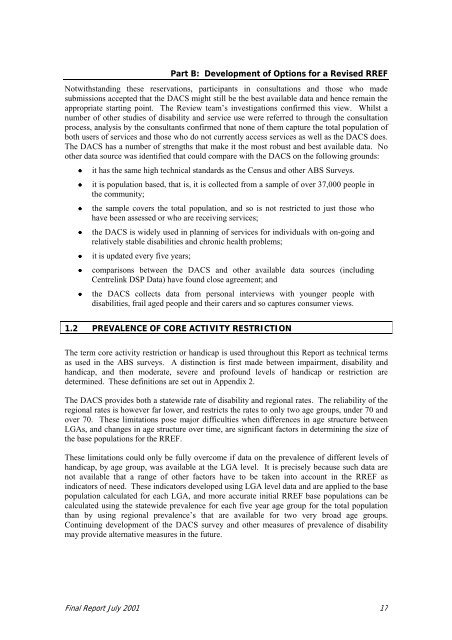Final Report on RREF 2001 - Department of Health
Final Report on RREF 2001 - Department of Health
Final Report on RREF 2001 - Department of Health
You also want an ePaper? Increase the reach of your titles
YUMPU automatically turns print PDFs into web optimized ePapers that Google loves.
Part B: Development <strong>of</strong> Opti<strong>on</strong>s for a Revised <strong>RREF</strong><br />
Notwithstanding these reservati<strong>on</strong>s, participants in c<strong>on</strong>sultati<strong>on</strong>s and those who made<br />
submissi<strong>on</strong>s accepted that the DACS might still be the best available data and hence remain the<br />
appropriate starting point. The Review team’s investigati<strong>on</strong>s c<strong>on</strong>firmed this view. Whilst a<br />
number <strong>of</strong> other studies <strong>of</strong> disability and service use were referred to through the c<strong>on</strong>sultati<strong>on</strong><br />
process, analysis by the c<strong>on</strong>sultants c<strong>on</strong>firmed that n<strong>on</strong>e <strong>of</strong> them capture the total populati<strong>on</strong> <strong>of</strong><br />
both users <strong>of</strong> services and those who do not currently access services as well as the DACS does.<br />
The DACS has a number <strong>of</strong> strengths that make it the most robust and best available data. No<br />
other data source was identified that could compare with the DACS <strong>on</strong> the following grounds:<br />
• it has the same high technical standards as the Census and other ABS Surveys.<br />
• it is populati<strong>on</strong> based, that is, it is collected from a sample <strong>of</strong> over 37,000 people in<br />
the community;<br />
• the sample covers the total populati<strong>on</strong>, and so is not restricted to just those who<br />
have been assessed or who are receiving services;<br />
• the DACS is widely used in planning <strong>of</strong> services for individuals with <strong>on</strong>-going and<br />
relatively stable disabilities and chr<strong>on</strong>ic health problems;<br />
• it is updated every five years;<br />
• comparis<strong>on</strong>s between the DACS and other available data sources (including<br />
Centrelink DSP Data) have found close agreement; and<br />
• the DACS collects data from pers<strong>on</strong>al interviews with younger people with<br />
disabilities, frail aged people and their carers and so captures c<strong>on</strong>sumer views.<br />
1.2 PREVALENCE OF CORE ACTIVITY RESTRICTION<br />
The term core activity restricti<strong>on</strong> or handicap is used throughout this <str<strong>on</strong>g>Report</str<strong>on</strong>g> as technical terms<br />
as used in the ABS surveys. A distincti<strong>on</strong> is first made between impairment, disability and<br />
handicap, and then moderate, severe and pr<strong>of</strong>ound levels <strong>of</strong> handicap or restricti<strong>on</strong> are<br />
determined. These definiti<strong>on</strong>s are set out in Appendix 2.<br />
The DACS provides both a statewide rate <strong>of</strong> disability and regi<strong>on</strong>al rates. The reliability <strong>of</strong> the<br />
regi<strong>on</strong>al rates is however far lower, and restricts the rates to <strong>on</strong>ly two age groups, under 70 and<br />
over 70. These limitati<strong>on</strong>s pose major difficulties when differences in age structure between<br />
LGAs, and changes in age structure over time, are significant factors in determining the size <strong>of</strong><br />
the base populati<strong>on</strong>s for the <strong>RREF</strong>.<br />
These limitati<strong>on</strong>s could <strong>on</strong>ly be fully overcome if data <strong>on</strong> the prevalence <strong>of</strong> different levels <strong>of</strong><br />
handicap, by age group, was available at the LGA level. It is precisely because such data are<br />
not available that a range <strong>of</strong> other factors have to be taken into account in the <strong>RREF</strong> as<br />
indicators <strong>of</strong> need. These indicators developed using LGA level data and are applied to the base<br />
populati<strong>on</strong> calculated for each LGA, and more accurate initial <strong>RREF</strong> base populati<strong>on</strong>s can be<br />
calculated using the statewide prevalence for each five year age group for the total populati<strong>on</strong><br />
than by using regi<strong>on</strong>al prevalence’s that are available for two very broad age groups.<br />
C<strong>on</strong>tinuing development <strong>of</strong> the DACS survey and other measures <strong>of</strong> prevalence <strong>of</strong> disability<br />
may provide alternative measures in the future.<br />
<str<strong>on</strong>g>Final</str<strong>on</strong>g> <str<strong>on</strong>g>Report</str<strong>on</strong>g> July <strong>2001</strong> 17
















